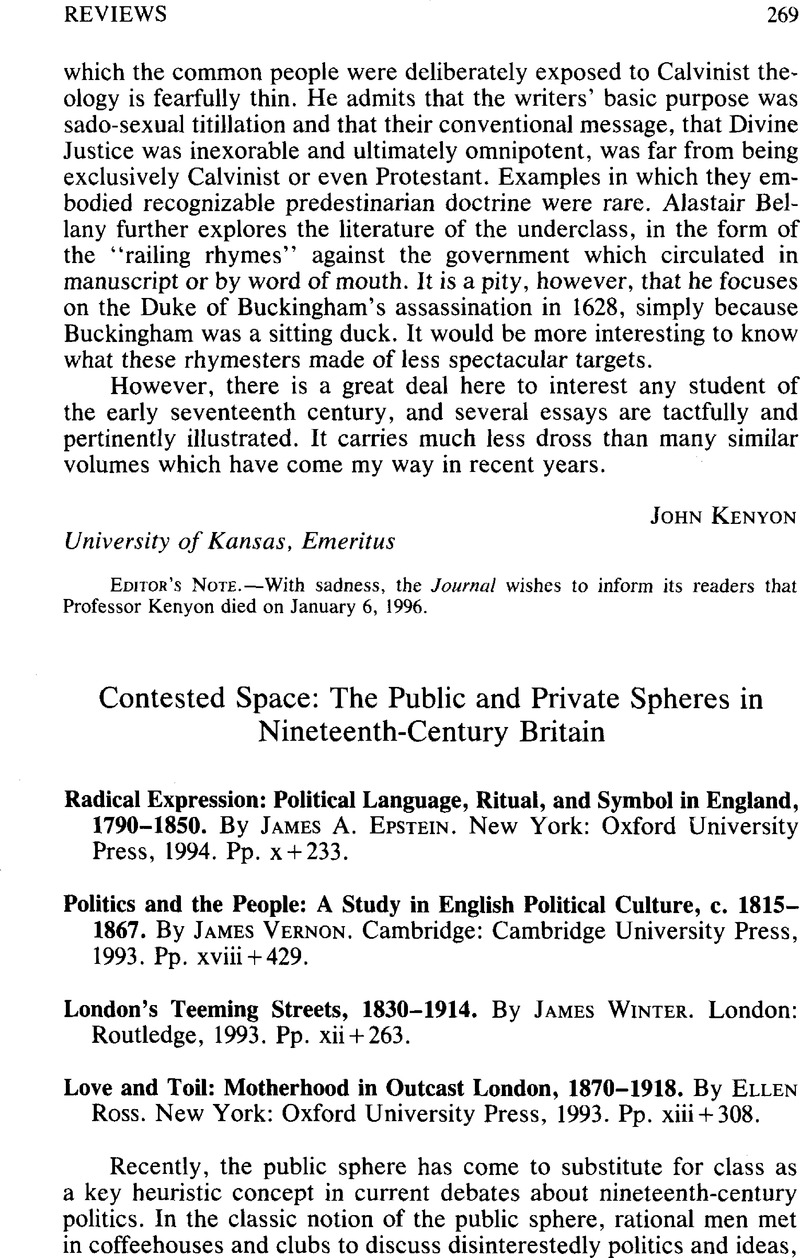Published online by Cambridge University Press: 10 January 2014

1 Habermas, Jürgen, The Structural Transformation of the Public Sphere, trans. Burger, Thomas (1962; reprint, Cambridge, Mass.: MIT Press, 1989), p. 173Google Scholar; Landes, Joan, Women and the Public Sphere in the Age of the French Revolution (Ithaca, N.Y., and London: Cornell University Press, 1988), p. 45Google Scholar.
2 See also Finn, Margot C., After Chartism: Class and Nation in English Radical Politics, 1848–1874 (Cambridge: Cambridge University Press, 1993), p. 189Google Scholar.
3 Joyce, Patrick, Visions of the People: Industrial England and the Question of Class, 1840–1914 (Cambridge: Cambridge University Press, 1991), p. 27CrossRefGoogle Scholar.
4 For a notable exception, see Brewer, John, “Theater and Counter-theater in Georgian Politics: The Mock Elections at Garrat,” Radical History Review 22 (1979–1980): 7–40CrossRefGoogle Scholar.
5 O'Gorman, Frank, Voters, Patrons and Parties: The Unreformed Electoral System of Hanoverian England, 1734–1832 (Oxford: Clarendon, 1989)Google Scholar.
6 For examples, see Clark, Anna, “The Rhetoric of Chartist Domesticity: Gender, Language and Class in the 1830s and 1840s,” Journal of British Studies 31, no. 1 (1992): 62–88CrossRefGoogle Scholar; Walkowitz, Judith, City of Dreadful Delight: Narratives of Sexual Danger in Late Victorian London (Chicago: University of Chicago Press, 1992), pp. 85–131CrossRefGoogle Scholar.
7 Bagehot, Walter, The English Constitution (1872; reprint, New York and London: Garland, 1978), p. xxxGoogle Scholar.
8 The collection Currents of Radicalism illuminates this problem to some extent (ed. Biagini, Eugenio F. and Reid, Alastair [Cambridge: Cambridge University Press, 1991])CrossRefGoogle Scholar: on continuity, see Shepherd, John, “Labour and Parliament: The Lib.-Labs as the First Working-Class MPs, 1885–1906” (pp. 187–213)Google Scholar, and Reid, Alastair J., “Old Unionism Reconsidered: The Radicalism of Robert Knight, 1870–1900” (pp. 214–43)Google Scholar, and on the new ideas, see Tanner, Duncan, “Ideological Debate in Edwardian Labour Politics: Radicalism, Revisionism and Socialism” (pp. 271–83)Google Scholar.
9 Biagini, Eugenio F., Liberty, Retrenchment, and Reform: Popular Liberalism in the Age of Gladstone (Cambridge: Cambridge University Press, 1992), p. 302Google Scholar.
10 For useful discussions of this problem which transcend the old paradigm, see Thane, Pat, “Labour and Local Politics: Radicalism, Democracy, and Social Reform,” in Biagini, and Reid, , eds.Google Scholar; and Lawson, Jane, Savage, Mike, and Warde, A., “Gender and Local Politics: Struggles over Welfare Policies,” in Localities, Class and Gender, ed. Murgatroyd, L.et al. (Oxford: Polity, 1985), pp. 195–217Google Scholar.